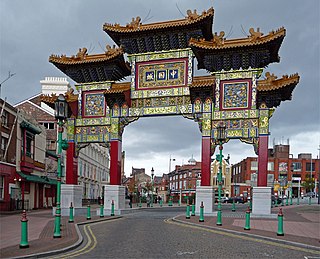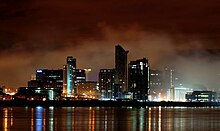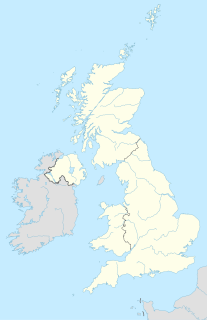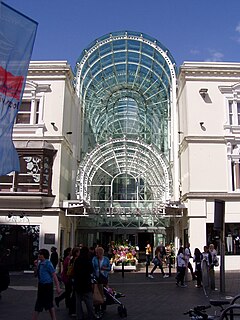| Liverpool city centre | |
|---|---|
 Aerial view of Liverpool city centre | |
Liverpool city centre shown within Merseyside | |
| Metropolitan borough | |
| Metropolitan county | |
| Region | |
| Country | England |
| Sovereign state | United Kingdom |
| Post town | LIVERPOOL |
| Postcode district | L1,2,3,6,7,8 |
| Dialling code | 0151 |
| Police | Merseyside |
| Fire | Merseyside |
| Ambulance | North West |
| EU Parliament | North West England |
| UK Parliament | |
Liverpool city centre is the commercial, cultural, financial and historical centre of Liverpool, England.

Liverpool is a city and metropolitan borough in North West England, with an estimated population of 491,500. Its metropolitan area is the fifth-largest in the UK, with a population of 2.24 million in 2011. The local authority is Liverpool City Council, the most populous local government district in the metropolitan county of Merseyside and the largest in the Liverpool City Region.
Contents
- Map
- Areas
- Canning
- Cavern Quarter
- Central Retail Area
- Chinatown
- Commercial District
- Cultural Quarter
- Hope Street
- Islington
- Knowledge Quarter
- Liverpool One
- Ropewalks
- Stanley Street Quarter
- Waterfront
- Architecture
- Culture
- Nightlife
- Retail
- Transport
- Universities
- References
- External links
The inner city districts of Vauxhall, Everton, Edge Hill, Kensington and Toxteth mark the border with Liverpool city centre which consists of the L1, L2 and L3 postal districts. The population of the city centre has grown dramatically to around 36,000. [1] [2]
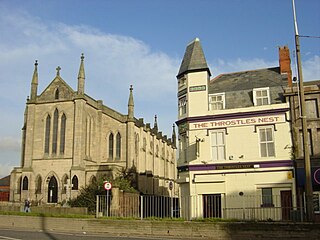
Vauxhall is an inner city district of Liverpool, Merseyside, England. It is located north of Liverpool city centre, and is bounded by Kirkdale in the north, and Everton in the east, with the docks and River Mersey running along the west side.

Everton is a district in Liverpool, in Merseyside, England, and a Liverpool City Council ward. Historically in Lancashire, at the 2001 Census the population was recorded as 7,398, increasing to 14,782 at the 2011 Census.
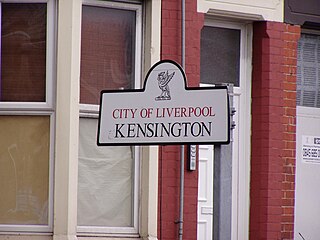
Kensington an inner city area of Liverpool, England. It is located immediately to the east of Liverpool city centre, and is bordered by Everton to the north, Fairfield to the east and Edge Hill to the south.
Liverpool was granted borough status in 1207, and the original seven streets of the settlement can now be found within the commercial district of Liverpool city centre. Many of Liverpool's most famous landmarks are located in the city centre and in 2006 Liverpool was visited by 625,000 international visitors alone, making it the fourth most visited city in the United Kingdom. [3] Six areas within Liverpool city Centre form the Liverpool Maritime Mercantile City which is a UNESCO designated World Heritage Site.

The Liverpool Maritime Mercantile City is a UNESCO designated World Heritage Site in Liverpool, England. It comprises six locations in the city centre of Liverpool including the Pier Head, Albert Dock and William Brown Street, and includes many of the city's most famous landmarks.

The United Nations Educational, Scientific and Cultural Organization is a specialized agency of the United Nations (UN) based in Paris. Its declared purpose is to contribute to peace and security by promoting international collaboration through educational, scientific, and cultural reforms in order to increase universal respect for justice, the rule of law, and human rights along with fundamental freedom proclaimed in the United Nations Charter. It is the successor of the League of Nations' International Committee on Intellectual Cooperation.
Liverpool city centre is one of the most architecturally significant locations in the country. Examples of architecture in Liverpool city centre include Liverpool Cathedral, [4] St. George's Hall, [5] the Royal Liver Building, Oriel Chambers, the world's first metal framed glass curtain walled building, and West Tower. [6]

Liverpool Cathedral is the Church of England Cathedral of the Diocese of Liverpool, built on St James's Mount in Liverpool and is the seat of the Bishop of Liverpool. It may be referred to as the Cathedral Church of Christ in Liverpool or the Cathedral Church of the Risen Christ, Liverpool, being dedicated to Christ 'in especial remembrance of his most glorious Resurrection'. Liverpool Cathedral is the largest cathedral and religious building in Britain.
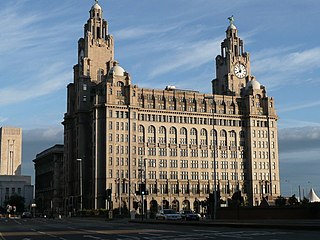
The Royal Liver Building is a Grade I listed building in Liverpool, England. It is located at the Pier Head and along with the neighbouring Cunard Building and Port of Liverpool Building is one of Liverpool's Three Graces, which line the city's waterfront. It is also part of Liverpool's UNESCO-designated World Heritage Maritime Mercantile City.

Oriel Chambers is the world's first building featuring a metal framed glass curtain wall. Designed by architect Peter Ellis and built in 1864, it is located on Water Street near the town hall in Liverpool, England. Due to its outstanding importance, it has been grade I listed.




